publications
2025
-
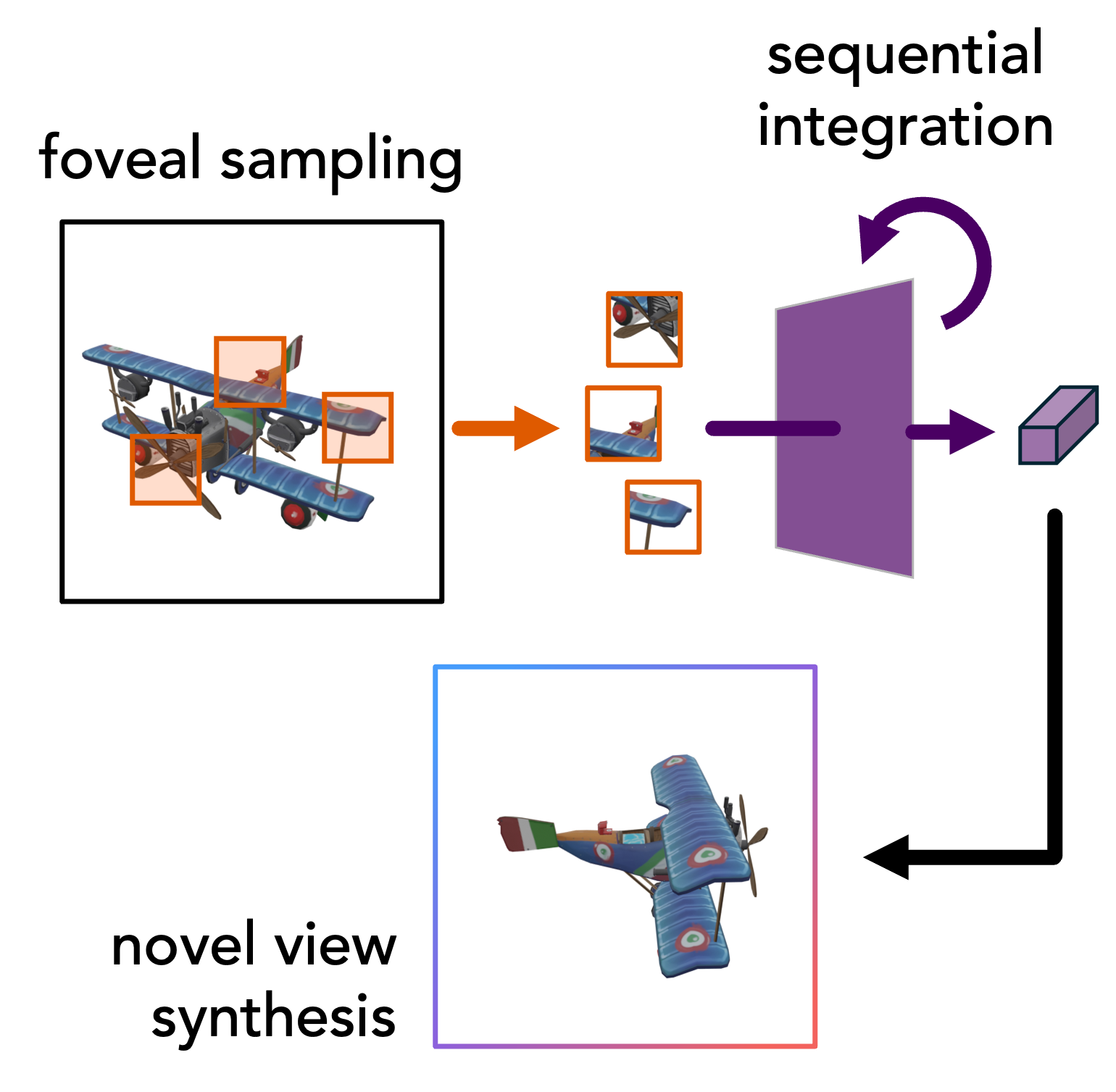 Stephanie Fu, Trevor Darrell*, and Tyler Bonnen*CCN oral (top 6.5%)CCN 2025
Stephanie Fu, Trevor Darrell*, and Tyler Bonnen*CCN oral (top 6.5%)CCN 2025Human vision is inherently sequential. This is largely because of foveal constraints on the retina, which demand that we shift our gaze to collect high-resolution information from throughout the environment. Within the domain of visual object perception, the neural substrates that support these sequential visual inferences have been well characterized: ventral temporal cortex (VTC) rapidly extracts visual features at each spatial location, while medial temporal cortex (MTC) integrates over the sequential outputs of VTC. This neurocomputational motif is absent in contemporary deep learning models of human vision. Not surprisingly, contemporary models approximate the rapid visual inferences that depend on VTC, but not those behaviors that depend on MTC (eg, novel 3D shape inference). Here we develop a modeling framework that embodies the sequential sampling/integration strategy emblematic of human vision. Given an image, this model first determines relevant locations to attend to, sequentially processes these locations as ‘foveated’inputs using a VTC-like model, then integrates over these sequential visual features within a MTC-like model. Here we report preliminary results on the design choices that lead to stable model optimization and subsequent model behaviors.
-
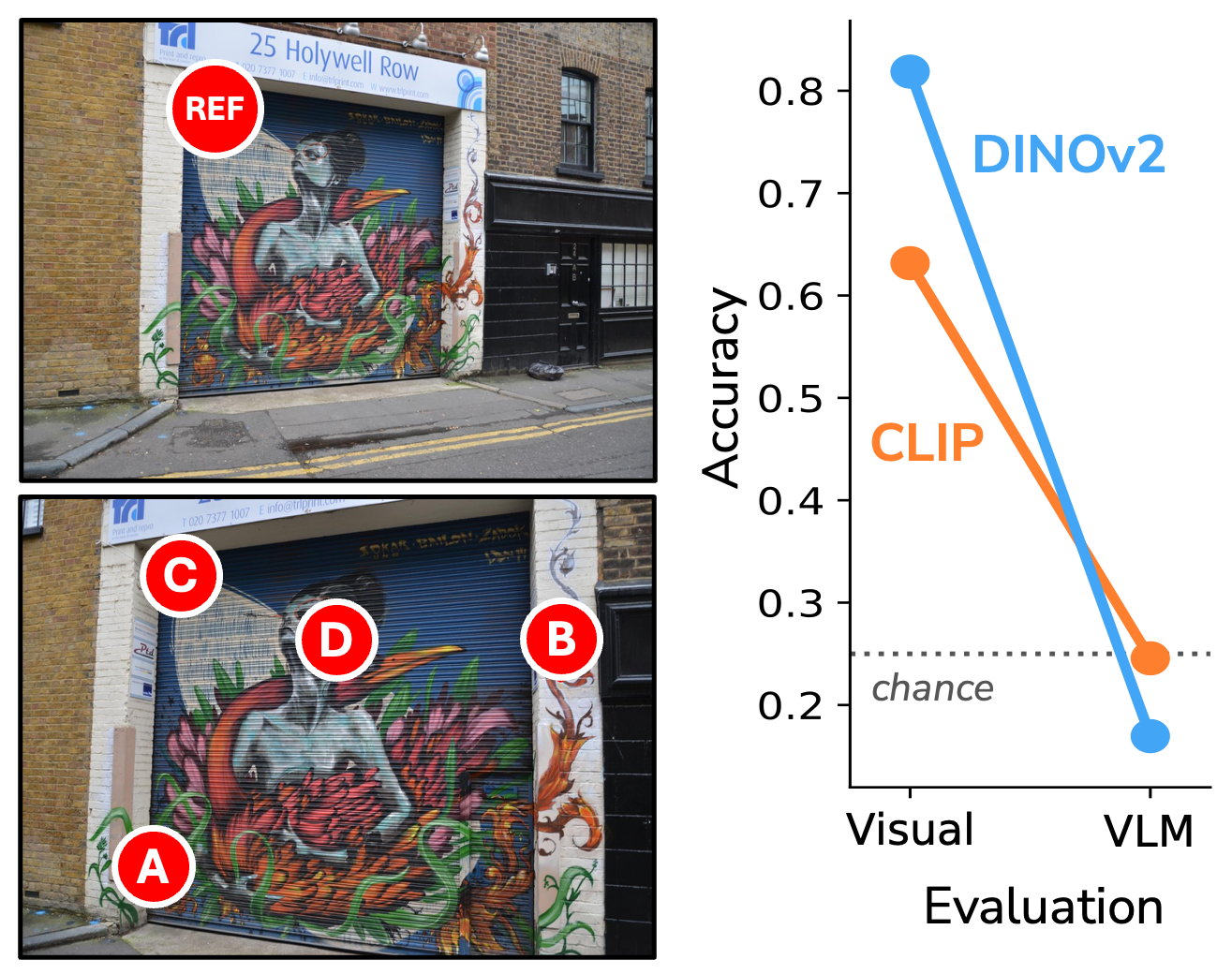 Stephanie Fu, Tyler Bonnen, Devin Guillory, and Trevor DarrellCOLM Outstanding Paper (top 0.9%)
Stephanie Fu, Tyler Bonnen, Devin Guillory, and Trevor DarrellCOLM Outstanding Paper (top 0.9%)
CVPR 2025 EVAL-FoMo 2 Workshop Best Paper AwardCOLM 2025Language provides a natural interface to specify and evaluate performance on visual tasks. To realize this possibility, vision language models (VLMs) must successfully integrate visual and linguistic information. Our work compares VLMs to a direct readout of their visual encoders to understand their ability to integrate across these modalities. Across a series of vision-centric benchmarks (e.g., depth estimation, correspondence), we find that VLMs perform substantially worse than their visual encoders, dropping to near-chance performance. We investigate these results through a series of analyses across the entire VLM: namely 1) the degradation of vision representations, 2) brittleness to task prompt, and 3) the language model’s role in solving the task. We find that the bottleneck in performing these vision-centric tasks lies in this third category; VLMs are not effectively using visual information easily accessible throughout the entire model, and they inherit the language priors present in the LLM. Our work helps diagnose the failure modes of open-source VLMs, and presents a series of evaluations useful for future investigations into visual understanding within VLMs.
-
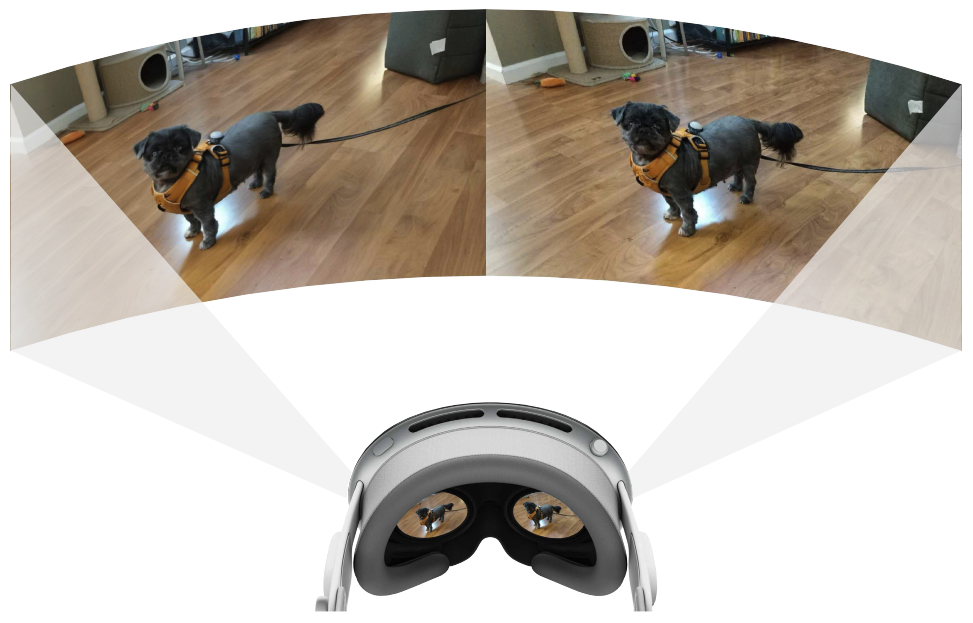 Netanel Y. Tamir, Shir Amir, Ranel Itzhaky, Noam Atia, Shobhita Sundaram, Stephanie Fu, Ron Sokolovsky, Phillip Isola, Tali Dekel, Richard Zhang, and Miriam FarberCVPR 2025 CV4Metaverse Workshop
Netanel Y. Tamir, Shir Amir, Ranel Itzhaky, Noam Atia, Shobhita Sundaram, Stephanie Fu, Ron Sokolovsky, Phillip Isola, Tali Dekel, Richard Zhang, and Miriam FarberCVPR 2025 CV4Metaverse WorkshopWith rapid advancements in virtual reality (VR) headsets, effectively measuring stereoscopic quality of experience (SQoE) has become essential for delivering immersive and comfortable 3D experiences. However, most existing stereo metrics focus on isolated aspects of the viewing experience such as visual discomfort or image quality, and have traditionally faced data limitations. To address these gaps, we present SCOPE (Stereoscopic COntent Preference Evaluation), a new dataset comprised of real and synthetic stereoscopic images featuring a wide range of common perceptual distortions and artifacts. The dataset is labeled with preference annotations collected on a VR headset, with our findings indicating a notable degree of consistency in user preferences across different headsets. Additionally, we present iSQoE, a new model for stereo quality of experience assessment trained on our dataset. We show that iSQoE aligns better with human preferences than existing methods when comparing mono-to-stereo conversion methods.
2024
-
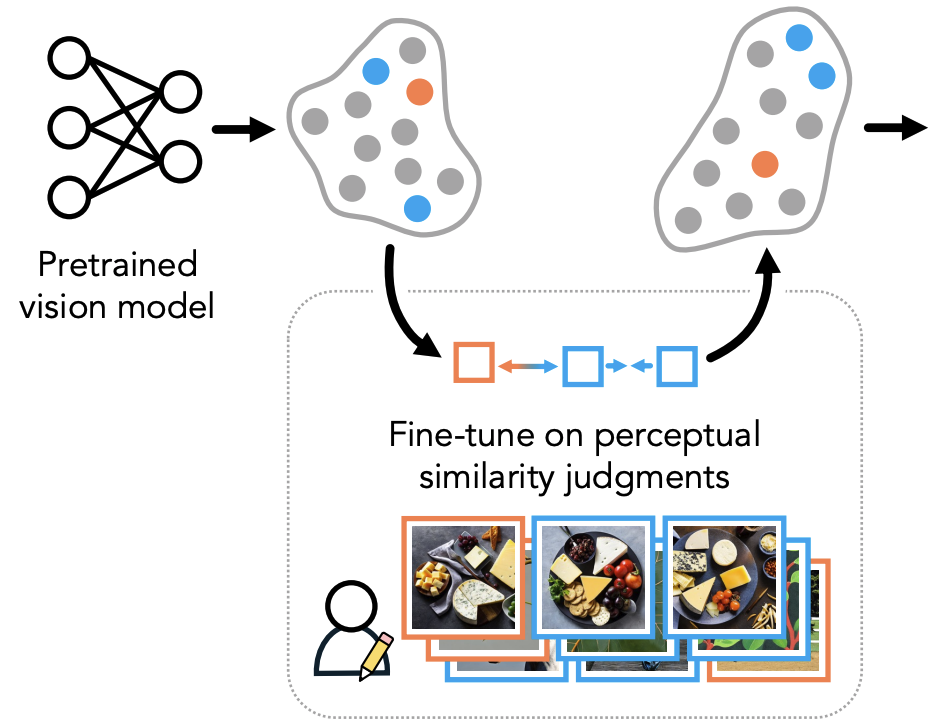 Shobhita Sundaram*, Stephanie Fu*, Lukas Muttenthaler, Netanel Y. Tamir, Lucy Chai, Simon Kornblith, Trevor Darrell, and Phillip IsolaNeurIPS 2024
Shobhita Sundaram*, Stephanie Fu*, Lukas Muttenthaler, Netanel Y. Tamir, Lucy Chai, Simon Kornblith, Trevor Darrell, and Phillip IsolaNeurIPS 2024Humans judge perceptual similarity according to diverse visual attributes, including scene layout, subject location, and camera pose. Existing vision models understand a wide range of semantic abstractions but improperly weigh these attributes and thus make inferences misaligned with human perception. While vision representations have previously benefited from alignment in contexts like image generation, the utility of perceptually aligned representations in more general-purpose settings remains unclear. Here, we investigate how aligning vision model representations to human perceptual judgments impacts their usability across diverse computer vision tasks. We finetune state-of-the-art models on human similarity judgments for image triplets and evaluate them across standard vision benchmarks. We find that aligning models to perceptual judgments yields representations that improve upon the original backbones across many downstream tasks, including counting, segmentation, depth estimation, instance retrieval, and retrieval-augmented generation. In addition, we find that performance is widely preserved on other tasks, including specialized out-of-distribution domains such as in medical imaging and 3D environment frames. Our results suggest that injecting an inductive bias about human perceptual knowledge into vision models can contribute to better representations.
-
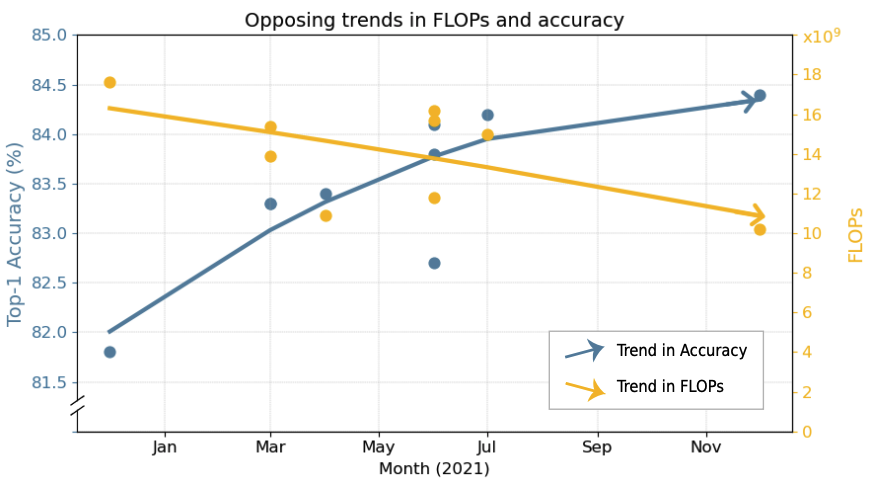 Ritwik Gupta, Leah Walker, Rodolfo Corona, Stephanie Fu, Suzanne Petryk, Janet Napolitano, Trevor Darrell, and Andrew W. Reddie
Ritwik Gupta, Leah Walker, Rodolfo Corona, Stephanie Fu, Suzanne Petryk, Janet Napolitano, Trevor Darrell, and Andrew W. ReddieCurrent regulations on powerful AI capabilities are narrowly focused on "foundation" or "frontier" models. However, these terms are vague and inconsistently defined, leading to an unstable foundation for governance efforts. Critically, policy debates often fail to consider the data used with these models, despite the clear link between data and model performance. Even (relatively) "small" models that fall outside the typical definitions of foundation and frontier models can achieve equivalent outcomes when exposed to sufficiently specific datasets. In this work, we illustrate the importance of considering dataset size and content as essential factors in assessing the risks posed by models both today and in the future. More broadly, we emphasize the risk posed by over-regulating reactively and provide a path towards careful, quantitative evaluation of capabilities that can lead to a simplified regulatory environment.
-
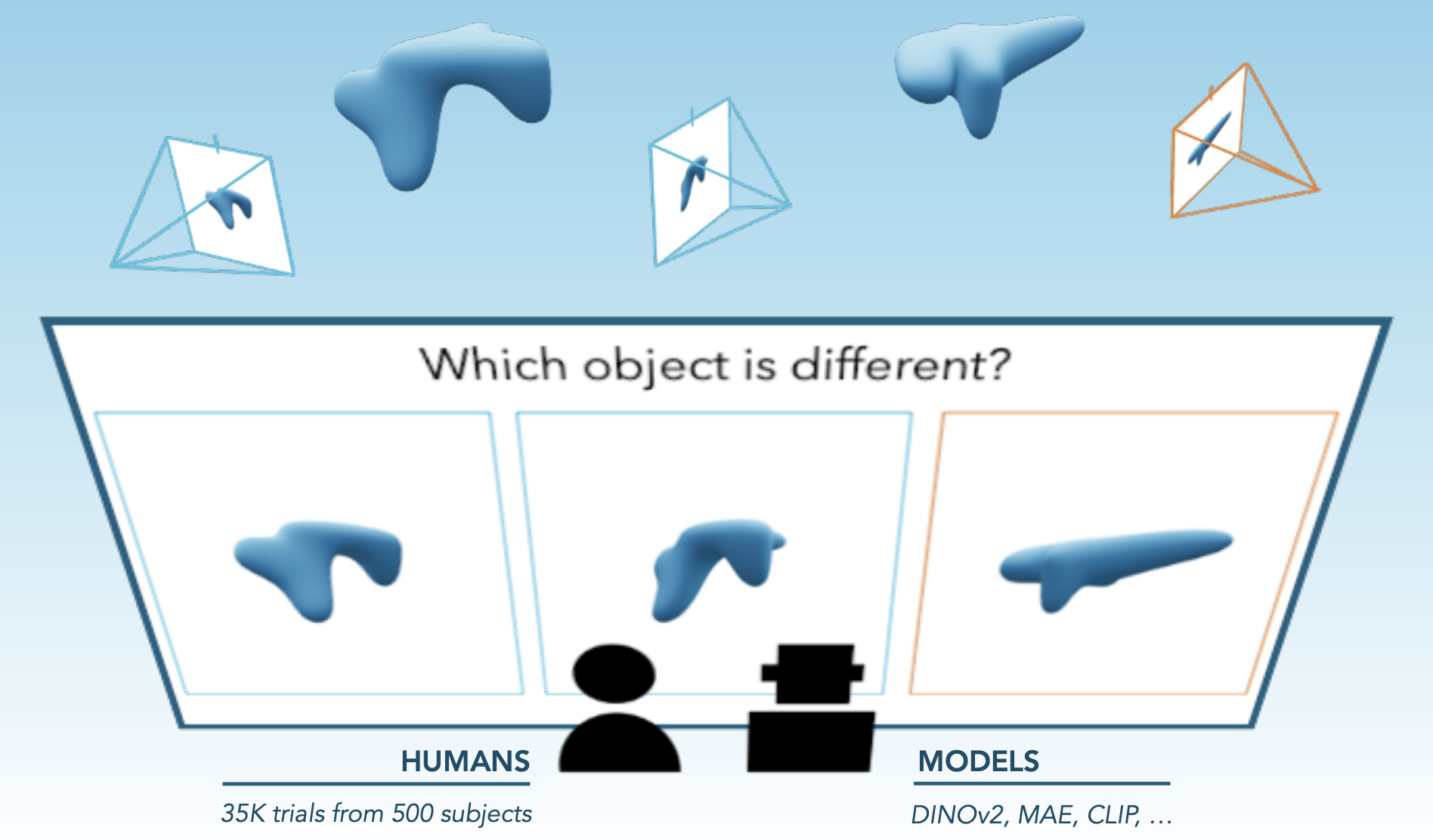 Tyler Bonnen, Stephanie Fu, Yutong Bai, Thomas O’Connell, Yoni Friedman, Nancy Kanwisher, Joshua B. Tenenbaum, and Alexei A. EfrosNeurIPS Datasets & Benchmarks 2024
Tyler Bonnen, Stephanie Fu, Yutong Bai, Thomas O’Connell, Yoni Friedman, Nancy Kanwisher, Joshua B. Tenenbaum, and Alexei A. EfrosNeurIPS Datasets & Benchmarks 2024We introduce a benchmark to directly evaluate the alignment between human observers and vision models on a 3D shape inference task. We leverage an experimental design from the cognitive sciences which requires zero-shot visual inferences about object shape: given a set of images, participants identify which contain the same/different objects, despite considerable viewpoint variation. We draw from a diverse range of images that include common objects (e.g., chairs) as well as abstract shapes (i.e., procedurally generated ‘nonsense’ objects). After constructing over 2000 unique image sets, we administer these tasks to human participants, collecting 35K trials of behavioral data from over 500 participants. This includes explicit choice behaviors as well as intermediate measures, such as reaction time and gaze data. We then evaluate the performance of common vision models (e.g., DINOv2, MAE, CLIP). We find that humans outperform all models by a wide margin. Using a multi-scale evaluation approach, we identify underlying similarities and differences between models and humans: while human-model performance is correlated, humans allocate more time/processing on challenging trials. All images, data, and code can be accessed via our project page.
-
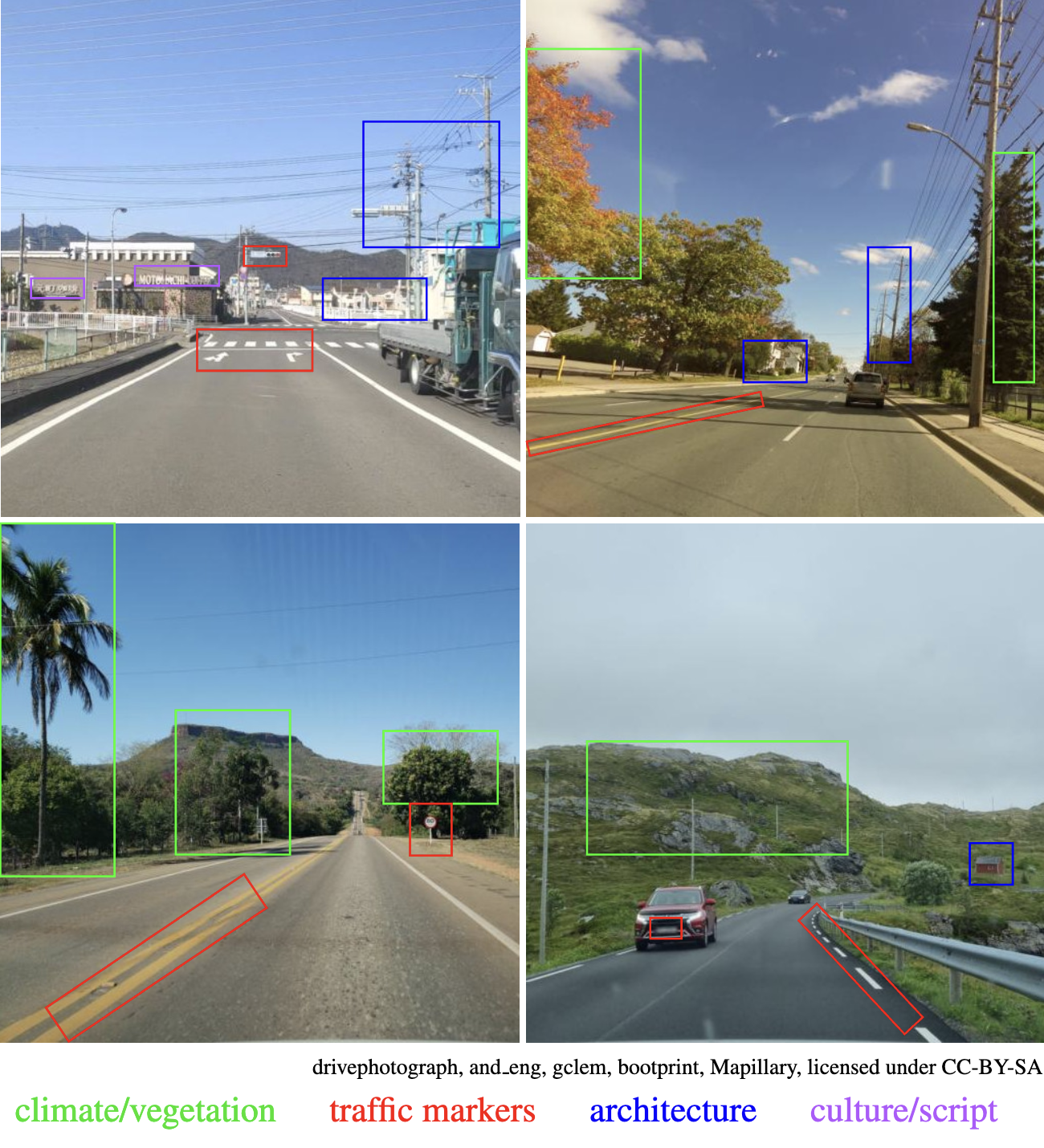 Guillaume Astruc, Nicolas Dufour, Ioannis Siglidis, Constantin Aronssohn, Nacim Bouia, Stephanie Fu, Romain Loiseau, Van Nguyen Nguyen, Charles Raude, Elliot Vincent, Lintao XU, Hongyu Zhou, and Loic LandrieuCVPR 2024
Guillaume Astruc, Nicolas Dufour, Ioannis Siglidis, Constantin Aronssohn, Nacim Bouia, Stephanie Fu, Romain Loiseau, Van Nguyen Nguyen, Charles Raude, Elliot Vincent, Lintao XU, Hongyu Zhou, and Loic LandrieuCVPR 2024Determining the location of an image anywhere on Earth is a complex visual task, which makes it particularly relevant for evaluating computer vision algorithms. Yet, the absence of standard, large-scale, open-access datasets with reliably localizable images has limited its potential. To address this issue, we introduce OpenStreetView-5M, a large-scale, open-access dataset comprising over 5.1 million geo-referenced street view images, covering 225 countries and territories. In contrast to existing benchmarks, we enforce a strict train/test separation, allowing us to evaluate the relevance of learned geographical features beyond mere memorization. To demonstrate the utility of our dataset, we conduct an extensive benchmark of various state-of-the-art image encoders, spatial representations, and training strategies.
-
 Pratyusha Sharma, Tamar Rott Shaham, Manel Baradad, Stephanie Fu, Adrian Rodriguez-Munoz, Shivam Duggal, Phillip Isola, and Antonio TorralbaCVPR 2024
Pratyusha Sharma, Tamar Rott Shaham, Manel Baradad, Stephanie Fu, Adrian Rodriguez-Munoz, Shivam Duggal, Phillip Isola, and Antonio TorralbaCVPR 2024What does learning to model relationships between strings teach large language models (LLMs) about the visual world? We systematically evaluate LLMs’ abilities to generate and recognize an assortment of visual concepts of increasing complexity and then demonstrate how a preliminary visual representation learning system can be trained using models of text. As language models lack the ability to consume or output visual information as pixels, we use code to represent images in our study. Although LLM-generated images do not look like natural images, results on image generation and the ability of models to correct these generated images indicate that precise modeling of strings can teach language models about numerous aspects of the visual world. Furthermore, experiments on self-supervised visual representation learning, utilizing images generated with text models, highlight the potential to train vision models capable of making semantic assessments of natural images using just LLMs.
-
 Stephanie Fu, Mark Hamilton, Laura Brandt, Axel Feldman, Zhoutong Zhang, and William T. FreemanICLR 2024
Stephanie Fu, Mark Hamilton, Laura Brandt, Axel Feldman, Zhoutong Zhang, and William T. FreemanICLR 2024Deep features are a cornerstone of computer vision research, capturing image semantics and enabling the community to solve downstream tasks even in the zero- or few-shot regime. However, these features often lack the spatial resolution to directly perform dense prediction tasks like segmentation and depth prediction because models aggressively pool information over large areas. In this work, we introduce FeatUp, a task- and model-agnostic framework to restore lost spatial information in deep features. We introduce two variants of FeatUp: one that guides features with high-resolution signal in a single forward pass, and one that fits an implicit model to a single image to reconstruct features at any resolution. Both approaches use a multi-view consistency loss with deep analogies to NeRFs. Our features retain their original semantics and can be swapped into existing applications to yield resolution and performance gains even without re-training. We show that FeatUp significantly outperforms other feature upsampling and image super-resolution approaches in class activation map generation, transfer learning for segmentation and depth prediction, and end-to-end training for semantic segmentation.
2023
-
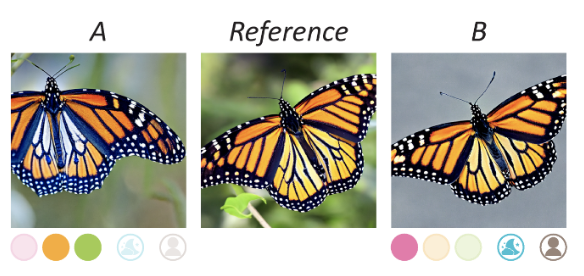 Stephanie Fu*, Netanel Tamir*, Shobhita Sundaram*, Lucy Chai, Richard Zhang, Tali Dekel, and Phillip IsolaNeurIPS 2023 Spotlight
Stephanie Fu*, Netanel Tamir*, Shobhita Sundaram*, Lucy Chai, Richard Zhang, Tali Dekel, and Phillip IsolaNeurIPS 2023 SpotlightCurrent perceptual similarity metrics operate at the level of pixels and patches. These metrics compare images in terms of their low-level colors and textures, but fail to capture mid-level similarities and differences in image layout, object pose, and semantic content. In this paper, we develop a perceptual metric that assesses images holistically. Our first step is to collect a new dataset of human similarity judgments over image pairs that are alike in diverse ways. Critical to this dataset is that judgments are nearly automatic and shared by all observers. To achieve this we use recent text-to-image models to create synthetic pairs that are perturbed along various dimensions. We observe that popular perceptual metrics fall short of explaining our new data, and we introduce a new metric, DreamSim, tuned to better align with human perception. We analyze how our metric is affected by different visual attributes, and find that it focuses heavily on foreground objects and semantic content while also being sensitive to color and layout. Notably, despite being trained on synthetic data, our metric generalizes to real images, giving strong results on retrieval and reconstruction tasks. Furthermore, our metric outperforms both prior learned metrics and recent large vision models on these tasks.
2022
-
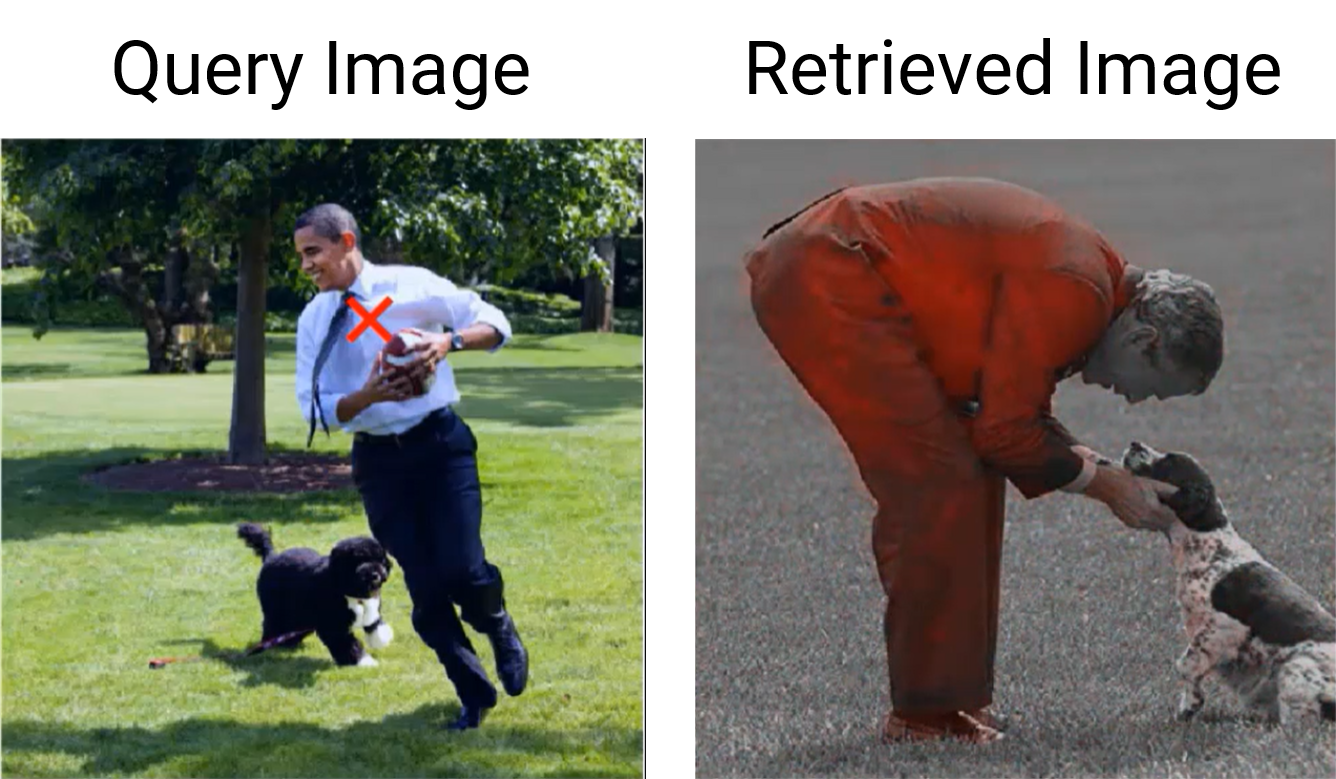 Mark Hamilton, Scott Lundberg, Lei Zhang, Stephanie Fu, and William T FreemanICLR 2022
Mark Hamilton, Scott Lundberg, Lei Zhang, Stephanie Fu, and William T FreemanICLR 2022Visual search, recommendation, and contrastive similarity learning power technologies that impact billions of users worldwide. Modern model architectures can be complex and difficult to interpret, and there are several competing techniques one can use to explain a search engine’s behavior. We show that the theory of fair credit assignment provides a unique axiomatic solution that generalizes several existing recommendation- and metric-explainability techniques in the literature. Using this formalism, we show when existing approaches violate "fairness" and derive methods that sidestep these shortcomings and naturally handle counterfactual information. More specifically, we show existing approaches implicitly approximate second-order Shapley-Taylor indices and extend CAM, GradCAM, LIME, SHAP, SBSM, and other methods to search engines. These extensions can extract pairwise correspondences between images from trained opaque-box models. We also introduce a fast kernel-based method for estimating Shapley-Taylor indices that require orders of magnitude fewer function evaluations to converge. Finally, we show that these game-theoretic measures yield more consistent explanations for image similarity architectures.
2021
-
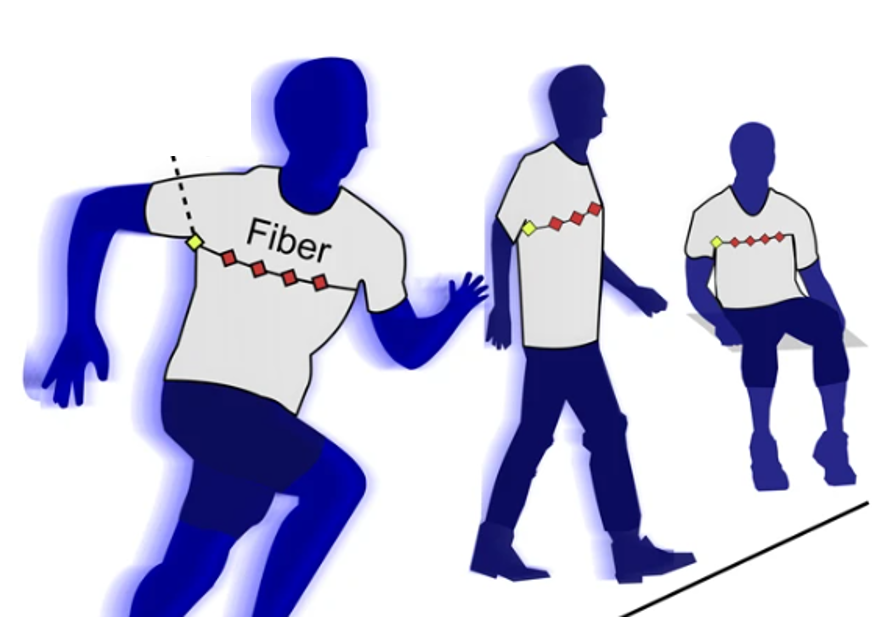 Gabriel Loke, Tural Khudiyev, Brian Wang, Stephanie Fu, Syamantak Payra, Yorai Shaoul, Johnny Fung, Ioannis Chatziveroglou, Pin-Wen Chou, Itamar Chinn, Wei Yan, Anna Gitelson-Kahn, John Joannopoulos, and Yoel FinkNature Communications
Gabriel Loke, Tural Khudiyev, Brian Wang, Stephanie Fu, Syamantak Payra, Yorai Shaoul, Johnny Fung, Ioannis Chatziveroglou, Pin-Wen Chou, Itamar Chinn, Wei Yan, Anna Gitelson-Kahn, John Joannopoulos, and Yoel FinkNature CommunicationsDigital devices are the essential building blocks of any modern electronic system. Fibres containing digital devices could enable fabrics with digital system capabilities for applications in physiological monitoring, human-computer interfaces, and on-body machine-learning. Here, a scalable preform-to-fibre approach is used to produce tens of metres of flexible fibre containing hundreds of interspersed, digital temperature sensors and memory devices with a memory density of ~7.6\thinspace\texttimes\thinspace105 bits per metre. The entire ensemble of devices are individually addressable and independently operated through a single connection at the fibre edge, overcoming the perennial single-fibre single-device limitation and increasing system reliability. The digital fibre, when incorporated within a shirt, collects and stores body temperature data over multiple days, and enables real-time inference of wearer activity with an accuracy of 96% through a trained neural network with 1650 neuronal connections stored within the fibre. The ability to realise digital devices within a fibre strand which can not only measure and store physiological parameters, but also harbour the neural networks required to infer sensory data, presents intriguing opportunities for worn fabrics that sense, memorise, learn, and infer situational context.